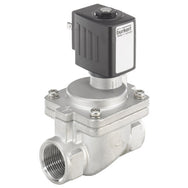Collection:Stainless Steel Solenoid Valves
2-way stainless steel solenoid valves offer durability, reliability, and versatility. Stainless steel has high resistance to corrosion and oxidation, making it an ideal material for valves used ... Read more
Stainless Steel Solenoid Valves

2-way stainless steel solenoid valves offer durability, reliability, and versatility. Stainless steel has high resistance to corrosion and oxidation, making it an ideal material for valves used in harsh environments or with corrosive media. Additionally, stainless steel can withstand high temperatures and pressures, which is essential for applications in industries that operate under extreme conditions.
The hygienic properties of stainless steel also make it a preferred choice for applications where cleanliness and non-contamination are paramount, such as in the food, beverage, and pharmaceutical industries. The smooth surface of stainless steel is easy to clean and does not harbor bacteria, ensuring that the media passing through the valve remains pure and uncontaminated.
Moreover, stainless steel 2-way solenoid valves are designed to be robust and long-lasting. The material's strength contributes to the valve's ability to maintain its integrity over many cycles and under continuous use. This durability translates to less frequent replacements and maintenance, providing cost savings and reducing downtime in critical processes.
Common applications for 2-way stainless steel solenoid valves
- Water treatment and purification
- Chemical processing
- Food and beverage production
- Pharmaceutical manufacturing
- Steam handling systems
- Fuel and oil distribution
- Medical and analytical equipment
- Pneumatic and hydraulic systems
- Marine and offshore engineering
- Gas distribution networks
- Automotive industry
- Agricultural irrigation systems
- HVAC systems
Selecting the right stainless steel 2-way solenoid valve
Consider the following selection criteria when browsing stainless steel 2-way solenoid valves on our website:
-
Stainless steel grade:
- Stainless steel 304 (1.4301): Commonly used, good for general use, not the best for very corrosive environments like the sea.
- Stainless steel 316 (1.4401): Better for corrosive environments, contains molybdenum for extra resistance to chemicals.
- Stainless steel 316L (1.4404): Like 316 but with less carbon, better for welding and varying temperatures without corrosion issues.
- Stainless steel 316Ti (1.4571): Similar to 316L but with titanium for high temperatures and to prevent corrosion after heating.
- Stainless steel 316 (1.4408): A cast form of 316, used for its different strengths in casting applications.
- Stainless steel 303 (1.4305): Easier to machine than 304 but with less corrosion resistance, not for very corrosive environments.
- Stainless steel 1.4581: Like 316 but stronger due to added nitrogen, good for tough applications needing more strength.
- Connection size: The connection size of a solenoid valve is a critical factor to consider. It must match the size of the piping in your system to ensure a proper fit and prevent leaks. Connection sizes are typically measured in inches and millimeters, and it is essential to select the correct size for efficient operation.
- Connection type: Common connection types include flange, push-on, and threaded. Flanged connections are ideal for larger pipes and high-pressure applications, push-on connections offer quick and easy installation, and threaded connections are suitable for smaller pipes and lower pressures.
- Function: Solenoid valves can be normally open (NO), normally closed (NC), or bistable. A normally open valve allows flow when de-energized and stops flow when energized, while a normally closed valve does the opposite. Bistable valves maintain their position even after the power is removed, requiring a pulse to change states.
- Voltage: The voltage required to operate the solenoid valve must be compatible with your system's power supply. Valves can be designed for various voltages and may be AC or DC. It is crucial to select a valve with the correct voltage specification to ensure proper operation and safety.
- Seal material: The seal material affects the valve's compatibility with different media and temperatures. Common seal materials include NBR, EPDM, Viton, and PTFE. Each material has its own advantages and is suitable for specific media and temperature ranges.
- Operation: The operation of a solenoid valve can be semi-direct, indirect, or direct. Semi-direct valves are suitable for low-pressure differentials, indirect valves require a minimum pressure differential to operate, and direct valves can function at zero pressure differential.
- Recommended media: The media that the valve is designed to control, such as air, water, oil, or gas, should be compatible with the valve's construction and seal material to prevent damage and ensure longevity.
- Pressure differential: The pressure differential is the difference in pressure between the inlet and outlet ports of the valve. It is important to select a valve that can handle the expected pressure differential in your system to prevent malfunction or failure.



